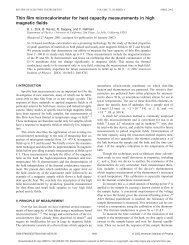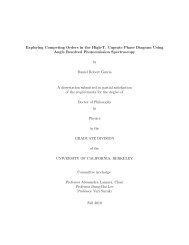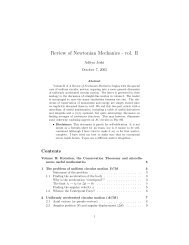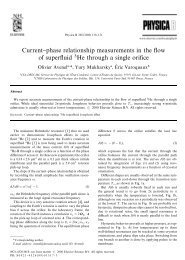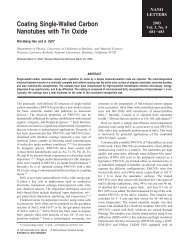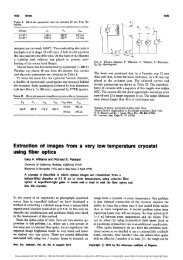Dirac Fermions in Graphene and Graphiteâa view from angle ...
Dirac Fermions in Graphene and Graphiteâa view from angle ...
Dirac Fermions in Graphene and Graphiteâa view from angle ...
You also want an ePaper? Increase the reach of your titles
YUMPU automatically turns print PDFs into web optimized ePapers that Google loves.
graphene is obta<strong>in</strong>ed <strong>from</strong> low energy electron microscopy (LEEM) data for each sample. The correspond<strong>in</strong>g<br />
<strong>angle</strong> resolved photoemission spectroscopy (ARPES) data at the K po<strong>in</strong>t for each sample are shown <strong>in</strong> panels<br />
d-f. The direct comparison between LEEM <strong>and</strong> ARPES data allows one to readily correlate the width of the<br />
photoemission features <strong>and</strong> the size of the excitation gap to the morphology of the films <strong>and</strong>, <strong>in</strong> particular,<br />
to the mean size of the s<strong>in</strong>gle layer graphene terraces. The ma<strong>in</strong> result of this figure is summarized <strong>in</strong> panel<br />
g. Although we see a slight <strong>in</strong>crease <strong>in</strong> the magnitude of the gap for the smallest terrace size, it is clear<br />
that as the terrace size exceeds 50 nm the gap plateaus at 180 meV. In contrast, the predicted <strong>and</strong> observed<br />
quantum conf<strong>in</strong>ement gap for exfoliated samples is shown as the dashed l<strong>in</strong>e. Clearly, for most of the terrace<br />
sizes we studied, the vanish<strong>in</strong>gly small gap <strong>in</strong>duced by quantum conf<strong>in</strong>ement can not account for what is<br />
observed <strong>in</strong> our data. These results show that while quantum conf<strong>in</strong>ement may have some contribution for<br />
small terrace sizes, the gap observed <strong>in</strong> samples with larger terraces is an <strong>in</strong>tr<strong>in</strong>sic property of s<strong>in</strong>gle layer<br />
epitaxial graphene <strong>and</strong> cannot be simply expla<strong>in</strong>ed by quantum conf<strong>in</strong>ement.<br />
4.5.3 Break<strong>in</strong>g of the sublattice symmetry due to graphene-substrate <strong>in</strong>teraction<br />
In our op<strong>in</strong>ion, the more likely scenario is the break<strong>in</strong>g of the A, B sublattice symmetry. This leads<br />
to the rehybridization of the valence <strong>and</strong> conduction b<strong>and</strong> states associated with the same <strong>Dirac</strong> po<strong>in</strong>t<br />
(Fig. 4.10(a)), result<strong>in</strong>g <strong>in</strong> a gap at all the K <strong>and</strong> K ′ po<strong>in</strong>ts. A necessary prediction of this scenario is<br />
the break<strong>in</strong>g of the six fold rotational symmetry of graphene near the <strong>Dirac</strong> po<strong>in</strong>t energy. For energy well<br />
above <strong>and</strong>/or below E D , the symmetry is restored. For bilayer <strong>and</strong> trilayer graphene, the break<strong>in</strong>g of the<br />
A, B sublattice equivalence can be a direct consequence of the the AB stack<strong>in</strong>g between different layers.<br />
Indeed, topographic Scann<strong>in</strong>g Tunnel<strong>in</strong>g Microscopy (STM) images for bilayer graphene have clearly shown<br />
<strong>in</strong>equivalent A <strong>and</strong> B sublattices 80,84 , similar to what has been observed for graphite 85 . This simply derives<br />
<strong>from</strong> the fact that one sublattice has carbon atoms directly below it while the other does not. Naively it<br />
seems that this explanation will not work for s<strong>in</strong>gle layer graphene. However, it is known that for epitaxially<br />
grown graphene, a buffer layer exists 50,49 (see Fig. 4.10(b)). ARPES study of the buffer layer has shown<br />
practically the same σ b<strong>and</strong>s as graphene while very different π b<strong>and</strong>s 49 . This is because the π orbitals have<br />
hybridized with the dangl<strong>in</strong>g bonds <strong>from</strong> the substrate. The fact that the σ b<strong>and</strong>s are unchanged suggests<br />
that, like graphene, the carbon atoms <strong>in</strong> the buffer layer have also the honeycomb arrangement with similar<br />
bond length. Consequently, although the buffer layer is electronically <strong>in</strong>active (absence of π orbitals) 49 ,<br />
structurally it can break the A, B sublattice symmetry when a s<strong>in</strong>gle layer of graphene grows upon it. This<br />
is particularly so <strong>in</strong> <strong>view</strong> of the small layer separation of ≈ 2 Å 50 <strong>and</strong> the AB stack<strong>in</strong>g usually expected for<br />
very th<strong>in</strong> graphene samples.<br />
For the s<strong>in</strong>gle <strong>and</strong> bilayer graphene, we use a tight b<strong>in</strong>d<strong>in</strong>g model with symmetry break<strong>in</strong>g on the A <strong>and</strong><br />
B sublattices to fit the symmetry break<strong>in</strong>g parameters to the observed energy gap. By fitt<strong>in</strong>g the dispersion,<br />
the symmetry break<strong>in</strong>g parameter <strong>in</strong> s<strong>in</strong>gle layer graphene, def<strong>in</strong>ed as half of the difference between the<br />
substrate potentials on the A <strong>and</strong> B sublattices, is determ<strong>in</strong>ed to be m ≈ 0.13 eV. In bilayer graphene, the<br />
symmetry break<strong>in</strong>g parameters <strong>in</strong> the top <strong>and</strong> bottom layers are m 1 ≈ 0.49 eV, m 2 ≈ −0.21 eV respectively.<br />
The magnitude of the symmetry break<strong>in</strong>g parameter is much bigger <strong>in</strong> the bottom graphene layer than that<br />
<strong>in</strong> s<strong>in</strong>gle layer graphene, because it is s<strong>and</strong>wiched between the buffer layer <strong>and</strong> the top graphene layer. The<br />
reason for m 2 to have the opposite sign is because of the AB stack<strong>in</strong>g. This cancels part of the effect <strong>in</strong> the<br />
bilayer graphene <strong>and</strong> decreases the gap. Therefore, for AB stack<strong>in</strong>g graphene, the eigen-functions average<br />
out for many layers, <strong>and</strong> the gap decreases rapidly.<br />
Fig. 4.11 shows additional support for the A, B sublattice symmetry break<strong>in</strong>g. Panels (a-d) show<br />
<strong>in</strong>tensity maps taken on s<strong>in</strong>gle layer graphene as a function of k x <strong>and</strong> k y at E F , -0.4, -0.8 eV <strong>and</strong> -1.0 eV<br />
respectively. The dom<strong>in</strong>ant features <strong>in</strong> these panels are the small pockets centered at the six corners of the<br />
Brillou<strong>in</strong> zone. Interest<strong>in</strong>gly, around each corner, there are six fa<strong>in</strong>t replicas form<strong>in</strong>g a smaller hexagon.<br />
The <strong>in</strong>tensity associated with them is ≈ 4% of the ma<strong>in</strong> <strong>in</strong>tensity. Closer <strong>in</strong>spection shows that the vectors<br />
connect<strong>in</strong>g the center of the small hexagon to its six corners are nearly the same as the second shortest<br />
33






